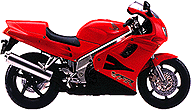

This article was originally posted by Chris "Moose" Moore to the VFR List, and he has graciously allowed me to post it here as a reference for others. It is an excellent post that has helped me and I hope it will be useful to other riders.
I was at Laguna Seca last September and having a heck of a time with the corkscrew. Turn 11 and turn 2 both had me messed up too, but that's a different story.
After one trip through turn 8, an instructor pulled me over and we chatted. He took the key out of my bike and said "Are you countersteering in the corkscrew?" And when I offered that I was attempting to do so he said, abruptly, "Stop it! I used to use that technique there, too. You keep doing that and you are going to fall. You don't want to fall in the corkscrew. You keep sliding and sliding, through turn 9. Seems like you'll never stop."
At that point he attempted to discuss the merits of body-steering. He also showed me some tricks and asked me to follow him the next trip around the track. I didn't get it.
Later that day, I cornered a different instructor to ask his take on the situation. "OHHH boy, you don't want to be banging on the VFR's bars going through turn 8!" was how he started out. With a little experience and these two (2) instructor's help, I was turning the bike effortlessly and still getting great traction, even in the corkscrew. I was dragging the left peg in 2 and 5, and touched the right peg one (1) time each in 3 and 10. That's unheard of for a coward like me.
At the end of the day, I rode with Reg. I asked him to be gentle, but to show me his corner entry because that's what I was trying to learn that day.
The end result is this:
Keith Code is giving an example that works well for GP bikes (he rode 125 and 250 GP) but superbikes might need a little extra coercion. Also, when Code first put forth the idea that countersteering was THE WAY TO GO was back when Freddy Spencer was just winning races and everyone else had just started hanging-off. Most of Code's style was developer back before fully-fared sportbikes and stiff perimeter frames even existed. Trail braking to the apex was foolhardy as you could wind those frames up like a spring and race tires were half as sticky as modern street tires that most of us use.
Reg talks about weighting the inside peg FOR STEERING. It increases the turn-in ability of the bike, especially a stable bike like a VFR. It also works well for a larger bike at higher speeds than most of us will (should) ride on the streets. I'm talking race speeds here, like turn 1 at Laguna Seca (120 MPH on the VFR).
Reg also talks about hanging off and advises against it for inexperienced riders. Largely because "It can be exciting getting your weight back on top of the bike when you get the rear wheel loose!" He seems to think that turning in is a separate action from holding the turn and, in a slide. He also says that he'll gladly hang off - if he's getting paid enough to do it.
Having learned Reg's techniques, I never weight the outer peg and countersteer. Granted, a little countersteering goes on, but I have gathered a technique of dancing on the (inside) pegs, using hips, feet and leg-pressure to control the bike at turn-in. I can comfortably go deeper in a corner than before and even hold the deceleration all the way to the apex if need be (say I waited a little longer than normal to roll off).
I think that either technique, taken in context, can be useful. I do know that banging on the front-end like Code professes is less necessary if you use the pegs to your advantage. Likewise, weighting the inside peg forces the body into a "Correct" posture for a corner on a bigger bike. I haven't tried it on a ZX7-RR, where you are tattooed to the top of the tank, so I wonder if such a bike would be better suited to countersteering like Code reports.
You may also notice that even race bikes are getting less evil in their ergonomics these days. The 600 supersports and 750 superbikes, while not as relaxed as a VFR, are actually moving away from the back-breaking stretched out posture of yesteryear. I'd champion a guess that an F3 is one of the more comfortable bikes on the road and, with almost identical ergonomics, it goes darn fast on the track!
In my experience, at non-race speeds (never above 120), on one (1) race-track (Laguna Seca) and on the street, the VFR turns in better, is more stable and less prone to funny responses when I weight the inside peg and don't consciously countersteer.
However you choose to turn, Code, Pridmore or a combination of the two, I think the most important thing is that your weight is on the pegs. If your weight is down low, on an immovable point and narrowly focused so it is always the same, you will create the greatest predictability and stability in your handling. If your butt's a little forward or back, your left cheek hangs off more than your right, you get more exercise with your right arm then your left, or anything else is asymmetrical, it won't matter so much if all your weight's on an immovable 4 inch long piece of metal below the CG of the bike. Your feel is increased, bike response is increased and your comfort level in a deep turn may even increase.
-Moose (inside peg in a turn advocate)
